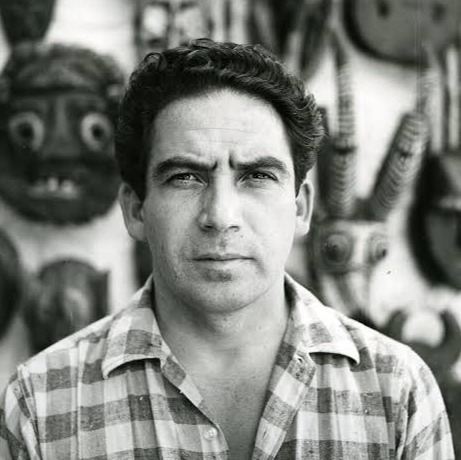
Oswaldo Vigas
Oswaldo Vigas, a Venezuelan artist renowned primarily as a painter and muralist, had a diverse body of work that encompassed painting, sculpture, printmaking, drawing, ceramics, and tapestry.
Biography of Oswaldo Vigas
Oswaldo Vigas was born in 1923 in Valencia, Carabobo, Venezuela. At the age of 12, he embarked on his journey of painting, a passion that began when his father passed away.
He pursued higher education, enrolling in medical studies at the University of the Andes (Universidad de los Andes) in Venezuela and later at the Universidad Central de Venezuela in Caracas, with aspirations of becoming a pediatrician. He successfully earned his degree in 1951. Concurrently with his medical studies, he immersed himself in the world of art, taking various art classes at the Taller Libre de Artes and attending the Escuela de Artes Plásticas Cristóbal Rojas, where he had the opportunity to interact with notable painters like Manuel Cabré and Pedro Ángel González.
In 1952, he achieved recognition by winning the National Visual Arts Award for his painting "La gran bruja" (1951) and concurrently held a significant solo exhibition at the Museo de Bellas Artes (Museum of Fine Arts) in Caracas. These accomplishments in 1952 paved the way for Vigas to relocate to Paris.
Upon his arrival in Paris, Vigas pursued further artistic education by enrolling at the École des Beaux-Arts and attending open courses at the Sorbonne. He also received a special commission to create five mosaic murals, which would ultimately become integral parts of the Universidad Central de Venezuela. This institution was later designated as a UNESCO World Heritage Cultural Site in 2000.
In 1954, Oswaldo Vigas represented Venezuela at the prestigious Venice Biennale, a testament to his international recognition. His art transcended borders, captivating audiences far beyond his homeland. In 1992, he made a significant impact at the XXVI International Prize of Contemporary Art of Monaco, where he received the first prize, solidifying his position among the world's foremost artists. In 1999, the Iberian-American FIA Art Fair honored him with the title of honored artist.
The artist died in 2014. Today, Oswaldo Vigas's artistic legacy lives on in the collections of esteemed public institutions and private collectors around the world. His works adorn the halls of prominent institutions such as the Museum of Fine Arts in Houston, the San Francisco Museum of Modern Art, the Art Museum of the Americas in Washington, D.C., the Musée des Beaux-Arts d'Angers, and the Musée des Beaux-Arts in Reims. His influence extends across continents, with pieces found in the Museo de Arte Moderno de Bogotá, the Museo Nacional de Bellas Artes in Santiago de Chile, and numerous other significant locations.
Oswaldo Vigas's Art Style
In his early paintings, Oswaldo Vigas concentrated on depicting the human figure, particularly the female form, and explored a theme that would endure as a consistent motif throughout his entire career: witches (brujas).
Throughout the majority of the 1950s, his artistic focus transitioned from the depiction of the human form to embracing constructivism and abstraction.
In 1955, after a visit to Picasso that left a lasting impact, Vigas found himself drawn towards anthropology and 'primitive cultures.' This fascination guided his artistic endeavors in the 1950s towards a quest for an authentic visual language. In this pursuit, he combined elements of gesture, geometry, and figurative representation. This creative exploration gradually led him to explore the connections between his work and the cultures of antiquity, as well as the concept of forging a distinctive personal identity shaped by elements of the earth, magic, and his own boundless imagination. These thematic elements are prominently evident in Oswaldo Vigas's artworks from the 1960s onward.
From the mid-60s onwards, Vigas' paintings gradually transitioned from informalism to a new figurative phase. In the 1980s, Vigas created a series of tapestries, ceramic works, and his first bronze-cast sculptures.
Years:
Born in 1923
Country:
Venezuela, Valencia
Gallery: